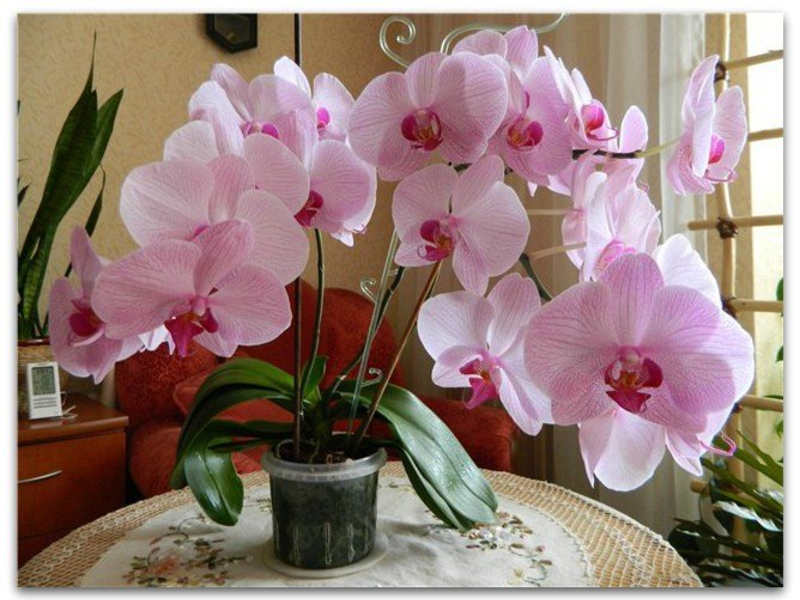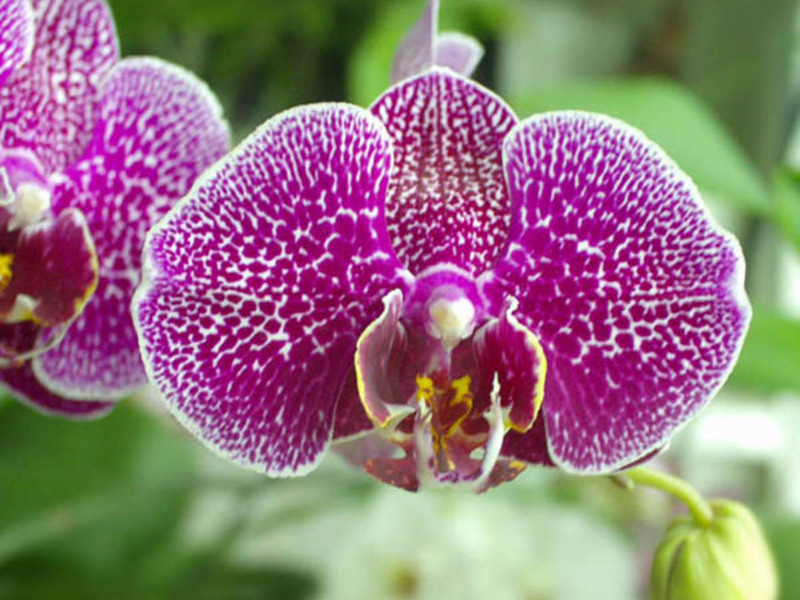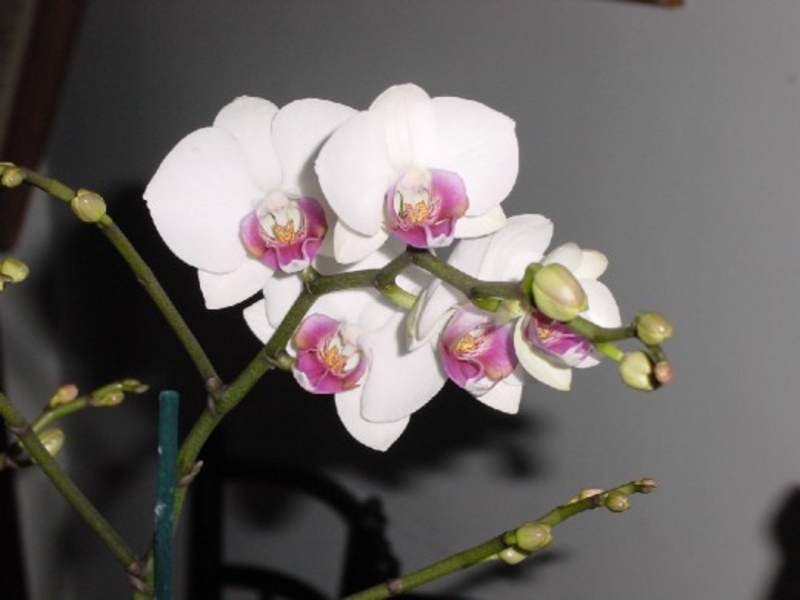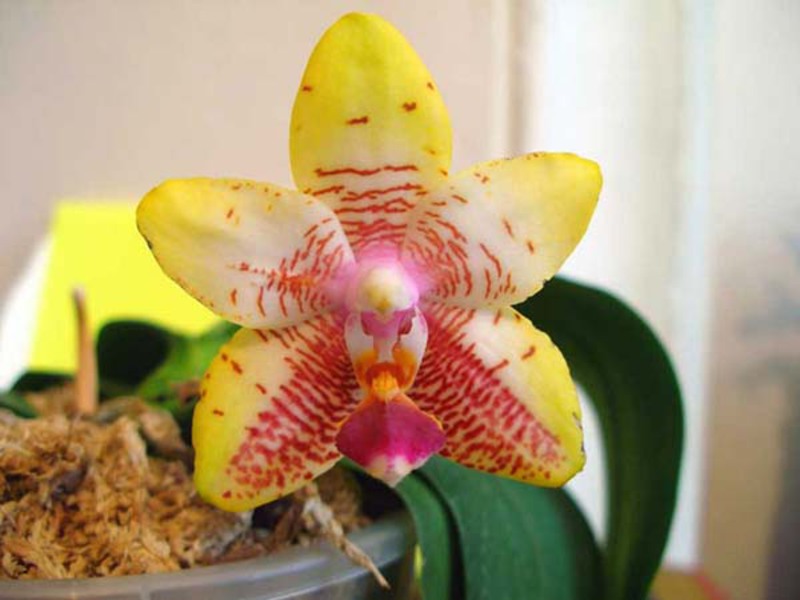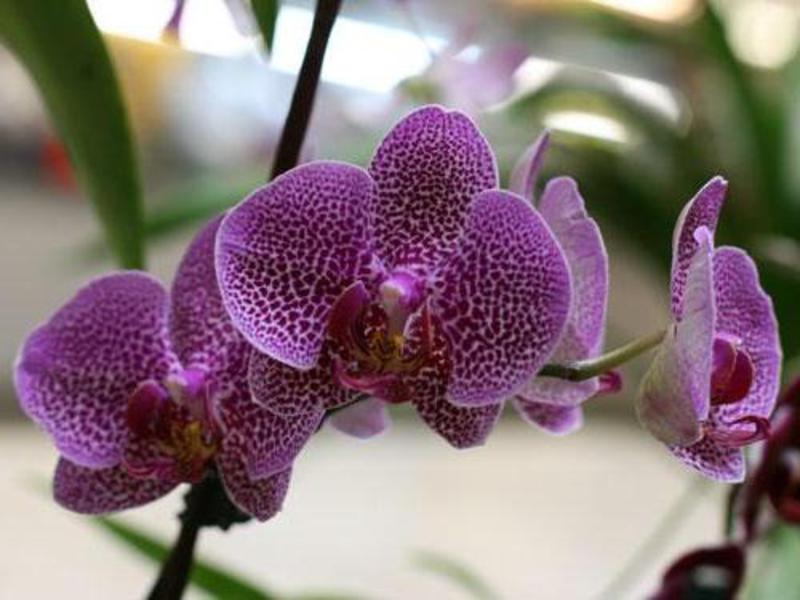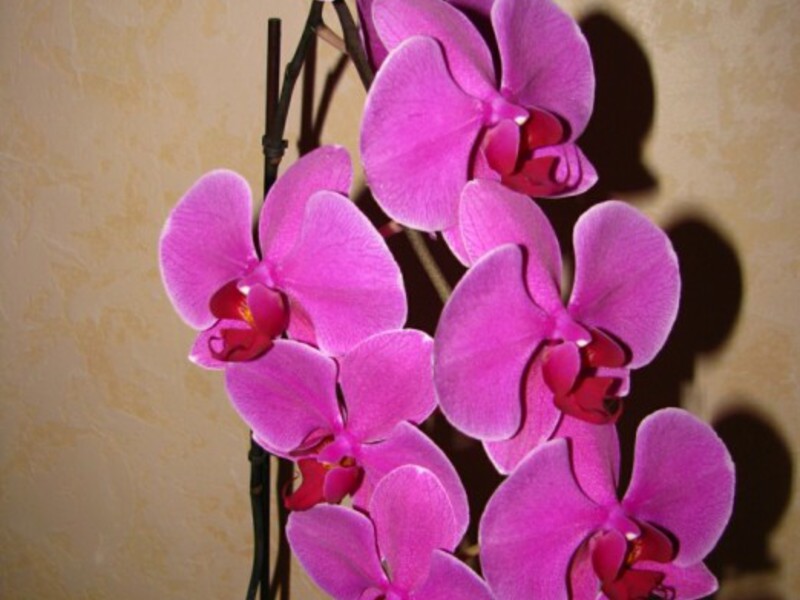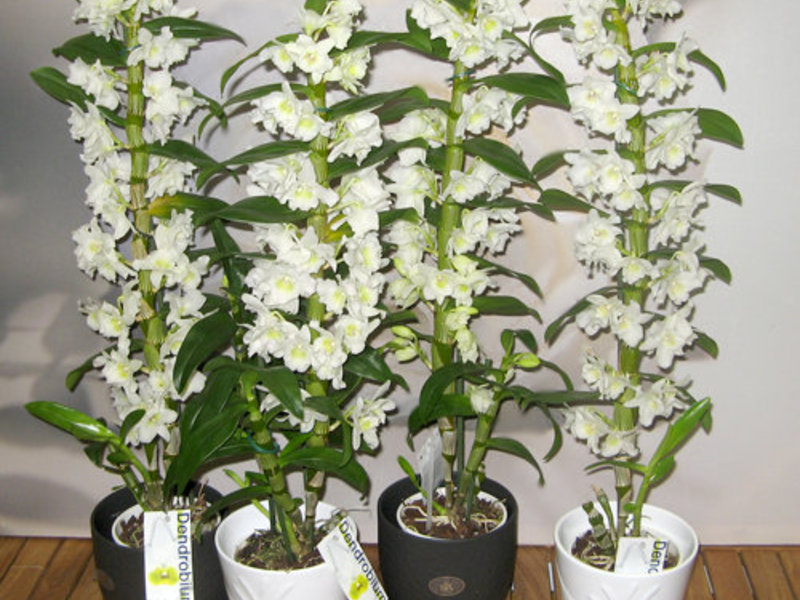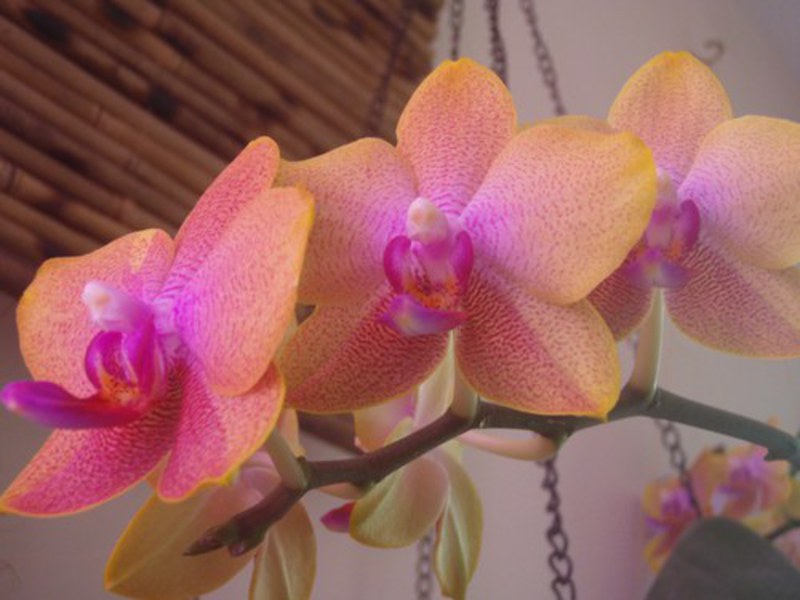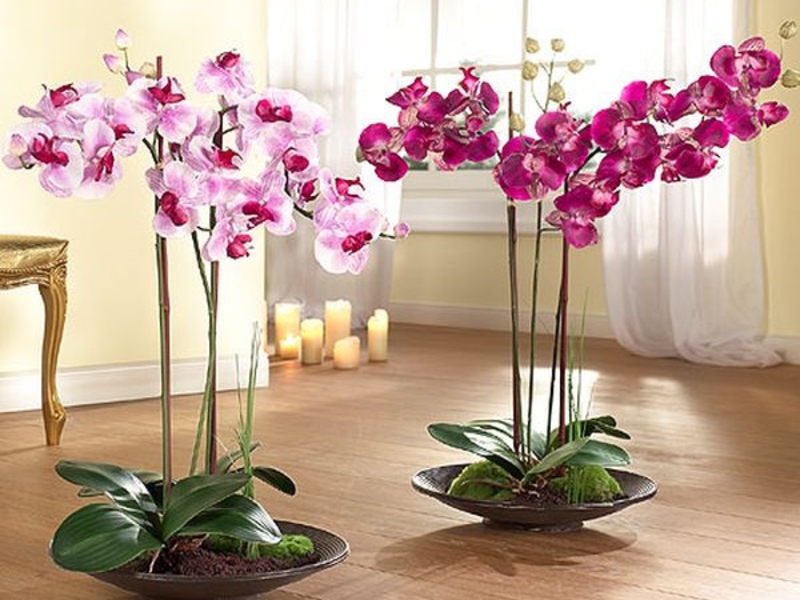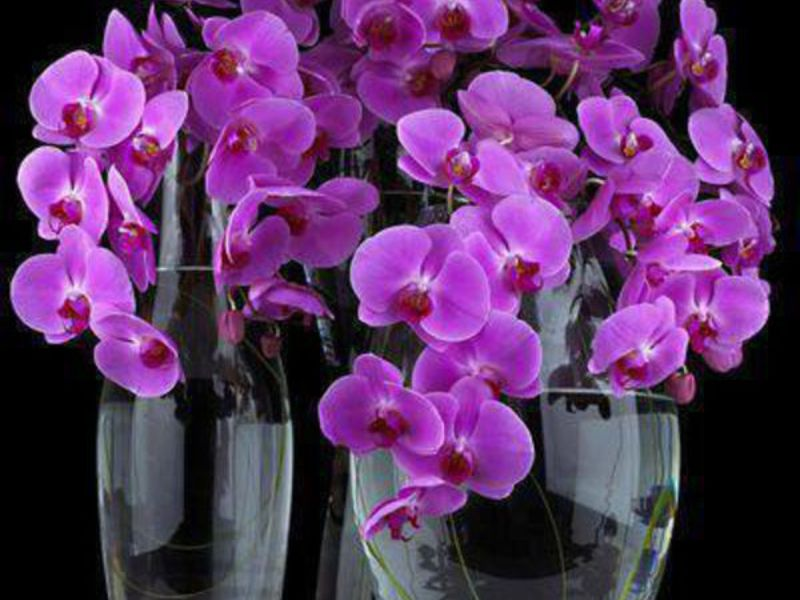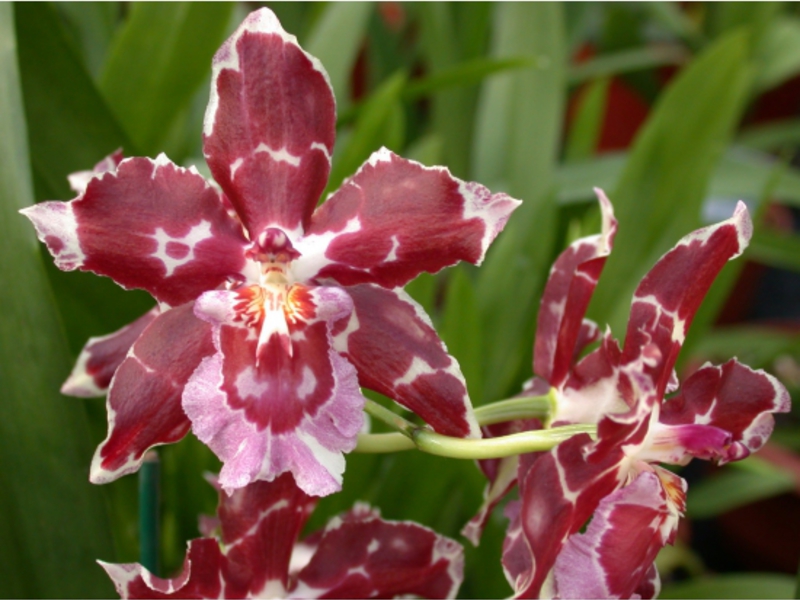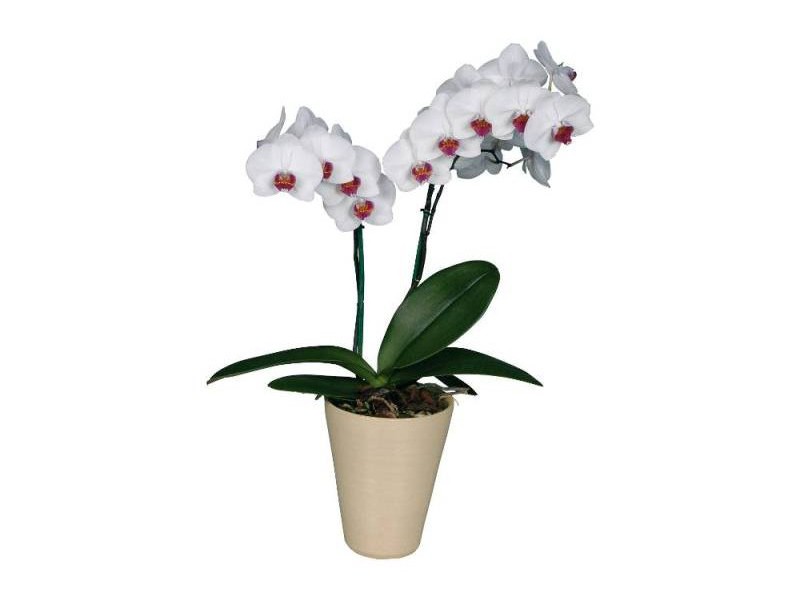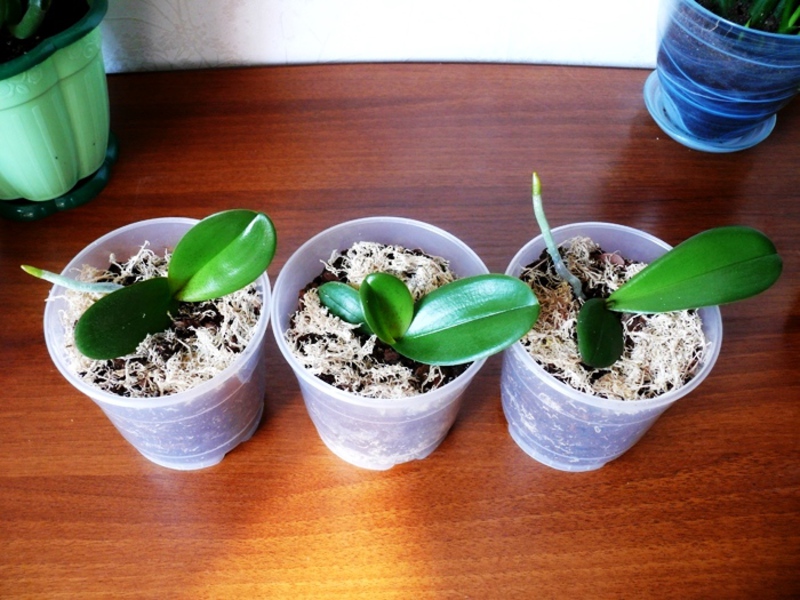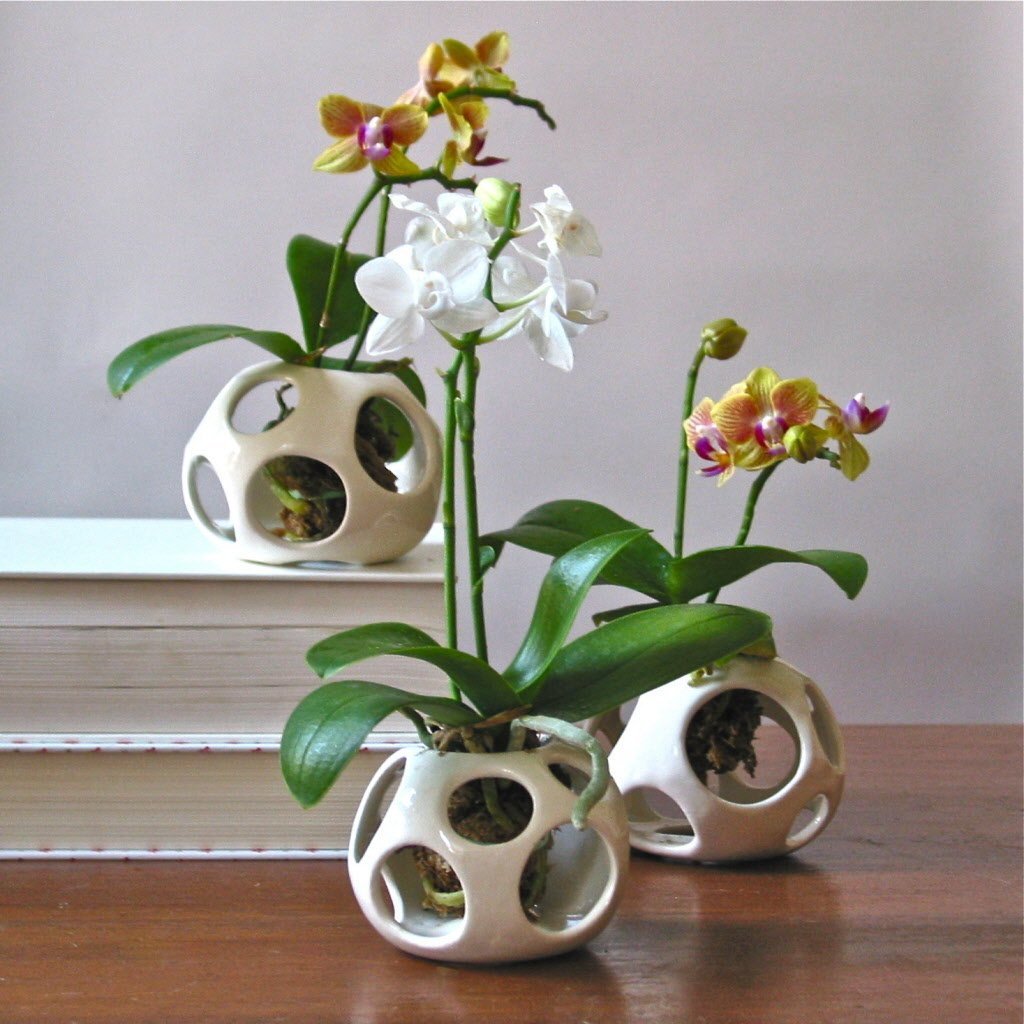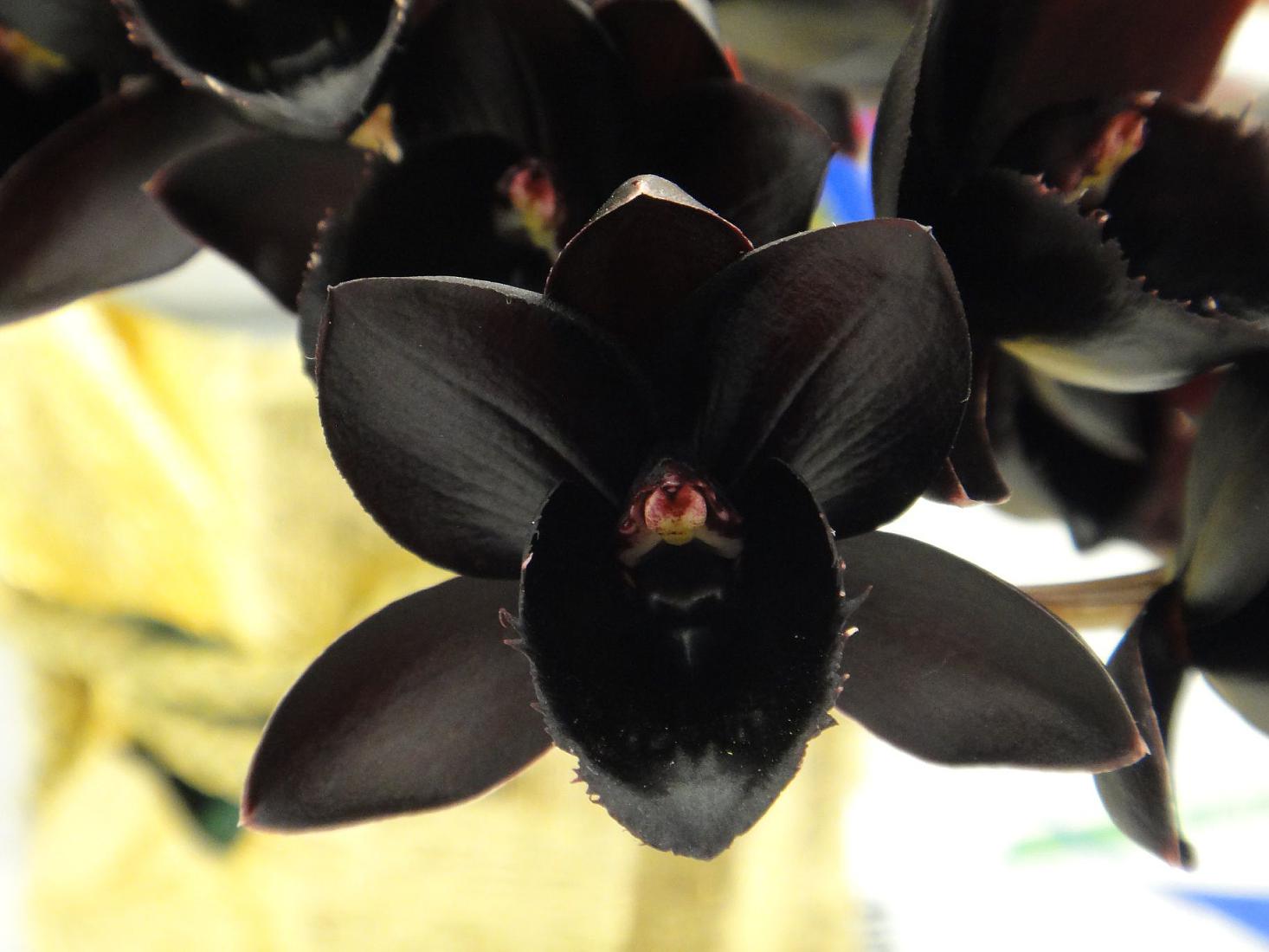Phalaenopsis are the most common and unpretentious orchid varieties. The family includes about 80 epiphytic species native to the rainforests of Australia and Indonesia. A distinctive feature of this species is monopodial growth - in this plant, the stem does not branch, but slowly grows upward, reaching 45 cm during flowering, giving several leaves every year.
Content
Phalaenopsis varieties
Of all the varieties in collections, as a rule, there are Phalaenopisis of Schindler, Stuart and the phalaenopisis is nice. The first two species have white flowers with reddish blotches and bright leaves. Selected forms of these orchids, which have more attractive and large inflorescences, are also of great interest.
Pleasant
This is the main plant species used for crossbreeding. Leaves, up to 4 pcs., Ovate-oblong, up to 35 cm in size, have a green color. Inflorescence is a large (45-75 cm) multicolor branched curved raceme, which carries 45-60 flowers... Sepals are white, with time they become creamy.
Schindler
This variety is similar to the pleasant phalaenopsis. However, it differs from it in that it has variegated leaves - silvery with green blotches, which merge into irregular longitudinal lines, below - red. This variety is considered the ancestor of a large number of hybrid varieties.
The inflorescence is rather large, up to 160 cm in size, multi-flowered (up to 150 pcs.) And branched. The flowers are slightly smaller, unlike the above-described variety (about 6 cm), bright pink, side leaves with reddish blotches.
Stewart
It has silvery roots and variegated leaves. The inflorescences are almost white, with multiple purple spots on the lateral leaves.
Sander
The rarest, most expensive and beautiful variety... Sander's flower is named in honor of a great connoisseur of orchids. Greenish leaves, with a variegated pattern. On large peduncles in rows there are up to 60 inflorescences about 6 cm in size. Their coloring is quite diverse.
This plant is not typical for this family. The flower itself is miniature, and the petals of the inflorescences are smaller than the sepals. The leaves are oblong, 12-25 cm in size. A peduncle of the same size has about 6 small flowers. Petals and bright colors. The lip is three-lobed and small.
Pink
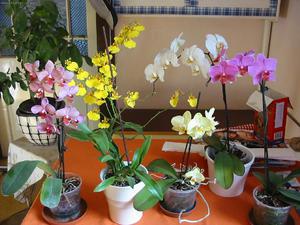 It has elongated or oval leaves, 12-14 cm in size, green, sometimes red at the bottom. Gracefully curved purple, rather small (18-25 cm) peduncle has 12-14 small pink flowersthat bloom in turn. Sepals are elongated, white with a pink transverse line.
It has elongated or oval leaves, 12-14 cm in size, green, sometimes red at the bottom. Gracefully curved purple, rather small (18-25 cm) peduncle has 12-14 small pink flowersthat bloom in turn. Sepals are elongated, white with a pink transverse line.
The lip is three-lobed, small: pink lobes look forward; the middle lobe has a diamond shape, variegated pink, with a brown tint near the base. Long-tip boot.
Giant
The leaves are green, up to half a meter in size and about 25 cm wide. The peduncle has a spike-shaped multiple inflorescence.The flowers are bright yellow, with a dark red blotch of about 5 cm.
Hybrid views
Also, not only varieties are very popular, but also multiple intergeneric orchids:
- Renantopsis from Renanter;
- Doritenopsis with Doritis;
- Asconopsis with Ascocentrum;
- Vandenopsis with Wanda.
The most important are the mixtures with Doritis pulcherima. It is not a large plant that resembles a small phalaenopsis with narrow and small leaves.
Phalaenopsis hybrid
This name refers to a huge class of hybrids: varieties, forms and species, both natural and artificial selection. Today there are thousands of different hybrids, which are characterized by long flowering, large flowers of a beautiful shade, or irregular lines.
You can often see today blue phalaenopsis... But when purchasing this magnificent flower, do not expect it to remain so permanently. This unique color is imparted with dyes that are washed out over time and the orchids get their natural white color.
But, you should not be upset, since after long years of work, scientists still received a natural, not a painted flower. Directly the flowers are about 6 cm in size, while on one flower it can bloom up to 25 inflorescences.
The most common types:
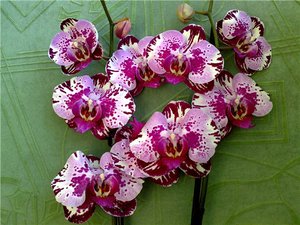 Paradise - the inflorescences are medium in size, with slightly elongated petals, a faint greenish color with a red-brown blotch, more concentrated at the bottom;
Paradise - the inflorescences are medium in size, with slightly elongated petals, a faint greenish color with a red-brown blotch, more concentrated at the bottom;- Cerise Streep - pink-lilac petals with a net of dark red veins; lip with a bright yellow base, multiple blotches and pink lines;
- Chromium - Greenish flowers, where the inner petals are much larger than the outer ones. The pure white lip is beautifully framed with orange edging;
- Malibu Chablis - large inflorescences, with round and wide petals inside, white. The lip is variegated crimson with white lines;
- Pending Bright - a large white inflorescence with a raspberry blotch, more pronounced below, petals slightly curved inward. The lip is crimson with yellow lines;
- Solden Bell - has a loose inflorescence. Petals of the same shape and length, light green with a small brown net;
- Sleido Sever - small inflorescences, with elongated petals, yellow with a net of pinkish veins.
Novelty-phalaenopsis
This is the name of hybrids in which peduncles do not die. They go into hibernation after flowering, and then grow out of the bud again, and new ones also grow - an adult orchid can have a couple of dozen inflorescences. Novelties can bloom up to 5 times annually... Typically, these hybrids have a small peduncle with few open flowers.
How to care for a flower?
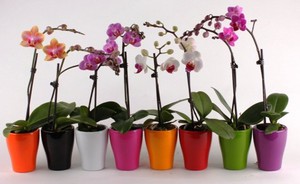 These varieties can be installed on the western and eastern windowsills without even using greenhouses, in the summer at a temperature of + 24 ... + 29C, in the winter - at least + 14C. A decrease in temperature at night stimulates the appearance of bud buds. On cold, cloudy days, it is best to arrange additional lighting.
These varieties can be installed on the western and eastern windowsills without even using greenhouses, in the summer at a temperature of + 24 ... + 29C, in the winter - at least + 14C. A decrease in temperature at night stimulates the appearance of bud buds. On cold, cloudy days, it is best to arrange additional lighting.
During growth in the summer, it is necessary to spray the flower every day. These plants will only bloom at humidity 60-85%... You can increase the moisture with a humidifier, or you can place the flowers on a tray filled with wet gravel.
If the capacity where the orchid grows becomes small, and the growth of the flower has decreased, then this means that it needs to be transplanted. As a rule, the transplant is done no more than once every 2 years. It must be done quite carefully so as not to injure delicate roots. It is advisable to cut or break the old container, and place the plant together with a lump of earth in a new container, adding soil.
This types of orchids a special substrate is needed, simple earth will not work. You can do it yourself: pine bark, charcoal and sphagnum. Under natural conditions, plants grow on trees.Roots provide them with water and minerals, therefore they need a lot of air. The larger the substrate, the better. In addition, it is advisable to choose transparent plastic pots for cultivation, where holes for drainage can be made.
When choosing a flower, pay attention to its root system. The roots must be green without any rotting or dryness. No need to worry when some of the roots come out of the pot. At the time of purchase, carefully inspect the flower: the main thing is a well-formed rounded inflorescence, it should not have any damage.
Probable problemsthat appear during cultivation:
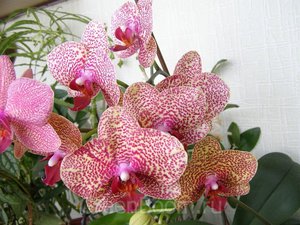 the plant has sluggish leaves - most likely the reason is in the very dry air. Flowers with a pot must be dipped in water for a couple of hours;
the plant has sluggish leaves - most likely the reason is in the very dry air. Flowers with a pot must be dipped in water for a couple of hours;- the plant has stopped growing - the flower is at a low temperature or overdried. The reason may be an untimely transplant (you can transplant only when new roots are formed);
- rotten roots - this is the cause of severe waterlogging. A clod of earth with roots must be thoroughly dried. Then do not water the flower while there is condensation in the pot;
- pests - can be infected with scabbard or spider mites. Maintaining high air humidity is the best preventive measure. Spray the plant frequently. To remove ticks, you need a diccofol-based acaricide;
- dried roots - when the dried root system gets brown, despite the sufficient moisture in the soil, this means that the flower is "overfed", salts have accumulated in its cells;
- burn spots on the plant are the result of exposure to the rays of the sun, cover the pot;
- the plant does not bloom - the reason is improper care, but if the flower was outwardly healthy before, then most likely it is a lack of light.
Orchid propagation
Usually, propagated by dividing the plant, it is cut with a knife into several parts, so that each has its own roots. Often dormant buds are formed into babies, they are transplanted after the formation of their roots. You can also propagate the plant by seed. Orchids that are grown from seed usually bloom the next year.
Growing recommendations
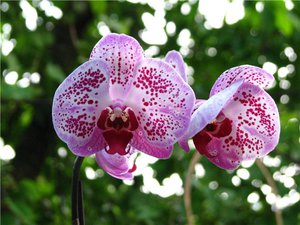 Blooming orchids are simply gorgeous and can be a decoration for any room. Hybrids can have flowers at any time, twice a year. On a large (up to half a meter) peduncle up to 14 inflorescences are formed... The colors are very different, there are types with orange, green, marble, yellow and other colors. A flowering plant indoors is sure to become the main focus. A beautiful flower speaks of a well-groomed home where peace and understanding prevail.
Blooming orchids are simply gorgeous and can be a decoration for any room. Hybrids can have flowers at any time, twice a year. On a large (up to half a meter) peduncle up to 14 inflorescences are formed... The colors are very different, there are types with orange, green, marble, yellow and other colors. A flowering plant indoors is sure to become the main focus. A beautiful flower speaks of a well-groomed home where peace and understanding prevail.
The blooming plant does not attract much attention in the living room, where the flower is surrounded by books, photos, paintings, decorations, etc., but it cannot be overlooked when it is alone on the coffee table in the hall. Having appeared, once in your home, these flowers over time will turn into full-fledged family members. Naturally, they cannot be considered a regular part of the design. Finding an orchid in phytodesign as the main element implies the choice of other elements of the composition, corresponding to vases, souvenirs or photos on this topic. Phalaenopsis - Great for pruning. A cut flower can keep freshness for a month.
Room microclimate
Graceful shapes of stems, original contours of leaves, fresh greens, flower buds. All this affects a person as the strongest psychological factor of calmness, self-affirmation and at the same time relieves stress and normalizes the nervous system.
Energy
This flower is perfect for creative individuals. Its graceful curves, the beauty of a flower will be able to awaken inspiration even from an inveterate "techie" and make them make their little creation.In addition, the plant itself allows great opportunities for creativity: you love to draw - it will give you great pleasure to draw a flower, you like to take a photo - choosing a background, an angle and setting up lighting for this will take more than one amazing hour.
Energy differs in rotational vibrations that are directed outward. Energy moves in a spiral from the middle of the flower with increasing circles. It has an exciting effect, gives strength, because plants with this energy do not need to be combined with flowers that emit cloud-like vibrations.
An orchid is a flower that will require careful maintenance. With the right approach, this plant will be able to please the owner with refined and elegant inflorescences for many years. The more attentively care is taken, the longer the flowering time.
